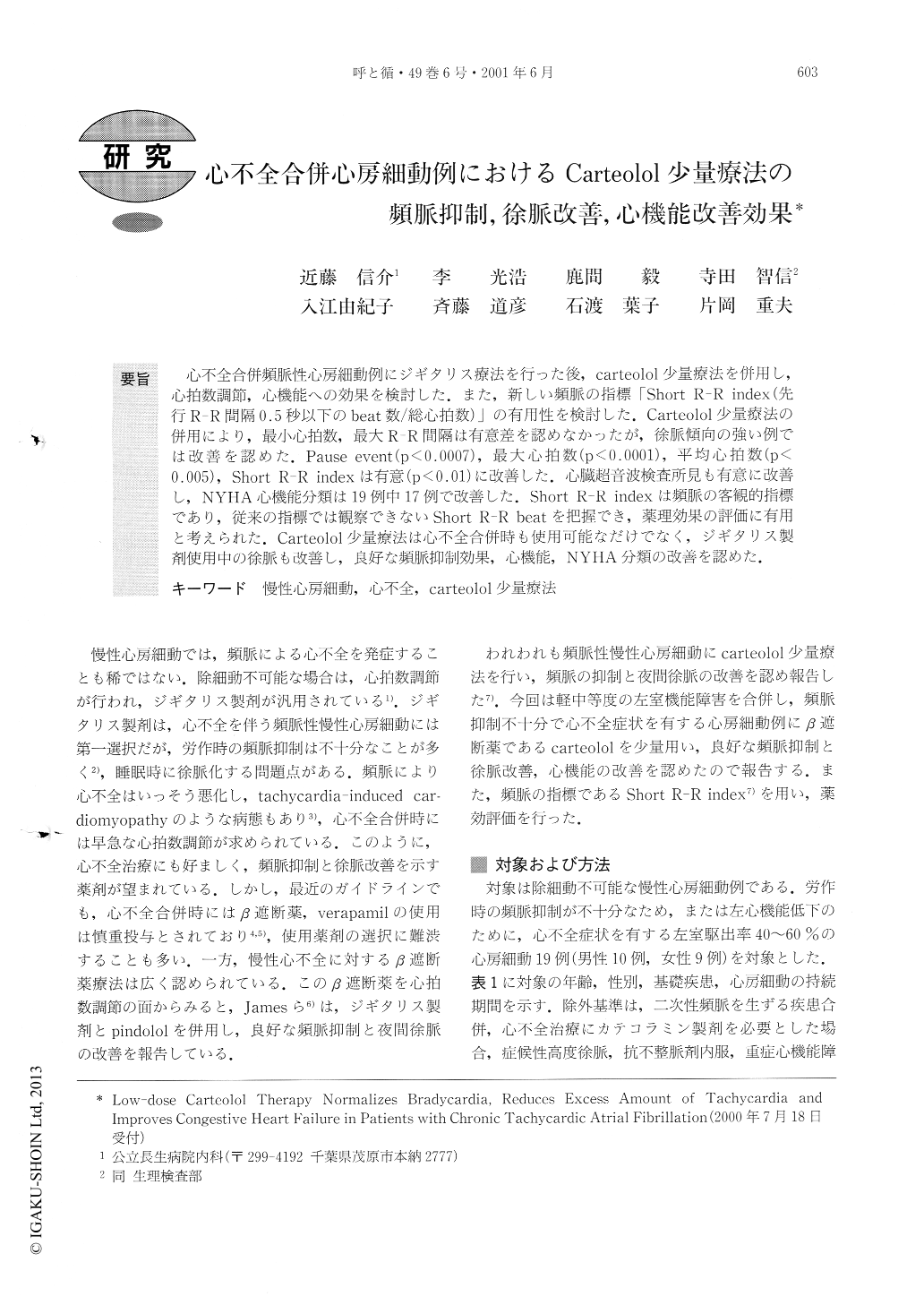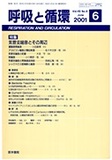Japanese
English
- 有料閲覧
- Abstract 文献概要
- 1ページ目 Look Inside
要旨 心不全合併頻脈性心房細動例にジギタリス療法を行った後,carteolol少量療法を併用し,心拍数調節,心機能への効果を検討した.また,新しい頻脈の指標「Short R-R index(先行R-R間隔0.5秒以下のbeat数/総心拍数)」の有用性を検討した,Carteolol少量療法の併用により,最小心拍数,最大R-R間隔は有意差を認めなかったが,徐脈傾向の強い例では改善を認めた.Pause event(p<0.0007),最大心拍数(p<0.0001),平均心拍数(p<0.005),Short R-R indexは有意(p<0.01)に改善した.心臓超音波検査所見も有意に改善し,NYHA心機能分類は19例中17例で改善した.Short R-R indexは頻脈の客観的指標であり,従来の指標では観察できないShort R-R beatを把握でき,薬理効果の評価に有用と考えられた.Carteolol少量療法は心不全合併時も使用可能なだけでなく,ジギタリス製剤使用中の徐脈も改善し,良好な頻脈抑制効果,心機能,NYHA分類の改善を認めた.
Digoxin should be considered as the first-line treatment in patients with chronic tachycardic atrial fibrillation (CTAf) complicated with congestive heart failure(CHF). Beta-antagonist should be considered as the second-line treatment. However, we often hesitate toadminister beta-antagonist to such patients because ofits negative inotropic effect. The first purpose of thisstudy was to evaluate the effect of low-dose carteolol onheart rate control and cardiac function in CTAf complicated with mild left ventricular dysfunction (LVDF).The second purpose of the study was to moke a clinicalevaluation of the new index “Short R-R index”.
The subjects of this study were 19 patients with CTAf complicated with mild CHF (NYHA II, III, and 40%<EF (left ventricular ejection fraction) <60%). Theywere already treated with conventional digoxin treatment for tachycardia and CHF. Before administrationof low-dose carteolol (1mg twice daily), we examinedthe patents using 24-hour ambulatory Holter ECG andechocardiography. We added low-dose carteolol to theirdigoxin therapy and examined 24-hour Holter ECG.NYIIA classification within 3 or 7 days and echocardiography within 2 weeks. Low-dose carteolol improvedmean HR (p<0.005), Max. FIR (p<0.0001), short R-Rindex (p<0.01). Pause event decreased (p<0.0007)significantly. Max. R-R interval and Min. FIR increasedslightly, but they were not significant. Before low-dose carteolol treatment, 5 patients showed NYHA class IIIand another patients showed NYHA class II. After low dose-carteolol treatment, only 2 patients showedNYHA class II and another patients showed NYHAclass I. Echocardiographic parameters such as LVDD(left ventricular diastolic diameter), EF and LAD (leftatrial diameter) improved significantly.
One of the important purposes of heart rate control isreduction of an excessive amount of short R-R intervals. Since it is difficult to evaluate short R-R intervalfrequency by conventional parameters, we created original parameters, “Short R-R index”. (Number of heartbeats less than 0.5-sec.)/ (Total heart beats) (%). Usingthese parameters, we found that low-dose carteololtherapy is guite effective in patients with many short R-R beats. We also found by quantitative measurementsthat low-dose carteolol with digoxin was better thandigoxin alone in reducing the short R-R beat number.
We concluded that low-dose carteolol and digoxincombined therapy is more effective than conventionaldigoxin treatment for heart rate control and for CHF ofCTAf patients and that the new index “Short R-Rindex” was clinically useful.

Copyright © 2001, Igaku-Shoin Ltd. All rights reserved.


